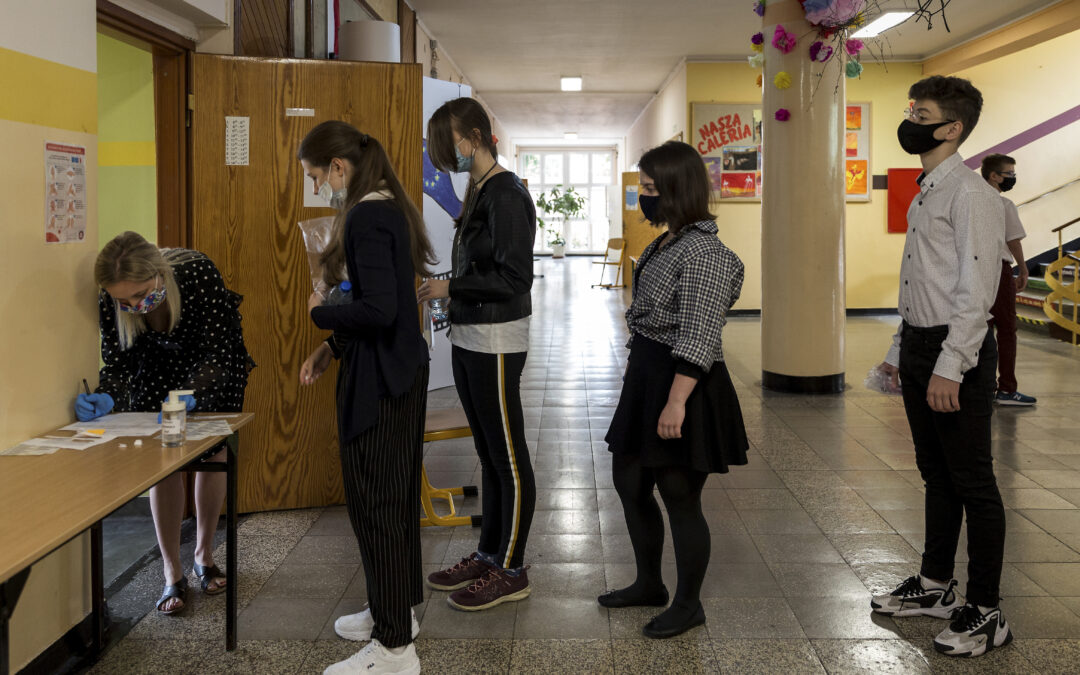The reopening of schools in Poland could cause new outbreaks of coronavirus similar to those in mines, new modelling has revealed, as uncertainty continues regarding plans for the return of face-to-face education.
The warnings come after the publication of draft Chief Sanitary Inspectorate (GIS) guidelines, which could allow schools to restart in-person teaching. But, with cases of coronavirus in Poland rising in the last few days, experts are concerned that schools may still be ill-prepared to fully resume classes.
According to models published in Dziennik Gazeta Prawna from the University of Warsaw’s Interdisciplinary Centre for Mathematical and Computational Modelling, an organisation which cooperates with the government, the reopening of schools could cause case numbers to increase several times over. The subsequent outbreaks may even resemble the recent severe spread of the virus in Poland’s mines.
In recent weeks, the highest number of new cases of coronavirus in Poland have come from mining areas, with Silesia continuing to be the epicentre of infections.
The scientists behind the analysis have cautioned that though knowledge about the spread of coronavirus among children is still unclear, restarting face-to-face education has the risk of causing an escalation of the outbreak in Poland.
“We adopted several models, because we do not know what the transmission is among young people, but it is certainly much lower than among adults,” Dr Franciszek Rakowski from the Centre told Dziennik Gazeta Prawna. “There is a confirmed example of a sick teenager who had several dozen contacts and yet did not infect anyone.”
GIS’s draft guidelines for school reopening include recommendations for frequent hand washing and encouraging more outdoor lessons. The document suggests there will be no need for mass temperature taking, nor for individual desks or the mandatory wearing of masks and gloves. However, masks may be needed for large gatherings of students, such as assemblies.
Administrative staff would also be encouraged to work remotely, and parents would be told not to bring students to school if they have any symptoms of infection.
The guidelines also contain specific recommendations to protect older teachers, with those over 50 years of age making up a third of the Polish school workforce. These teachers will be exempted from activities involving frequent contact with large numbers of children, such as day-care activities or break-time duty. They will also have to wear masks and gloves.
To monitor any resulting infections, schools will also need to implement procedures to promptly notify parents about new suspected cases. If coronavirus cases are confirmed, the province sanitary inspector will visit the school, and decide along with the headmaster whether it should close, with teaching then forced to go online.
However, experts have expressed concerns that even these recommendations may be insufficient to protect from further outbreaks. According to Onet, some have suggested that the closure of individual schools in the event of a coronavirus outbreak may not be enough to reduce the risk of infections spreading. The Centre behind the modelling scenarios is advising that decisions should depend on the number of cases in the entire province, with the decision to close schools taken at the local government level.
On Monday, deputy health minister Waldemar Kraska said a decision regarding children returning to school in September will be made depending on the epidemiological situation in mid-August. “It is hard for me to say at the moment whether young people will return to school. I would like it to happen, but whether it will be so, we will see,” Kraska told state broadcaster Polskie Radio. He also warned that Poland could face a double blow of a second wave of coronavirus and a flu outbreak in autumn.
Earlier, ministers had suggested that a hybrid form of education could be rolled out in September, with online teaching continuing if a second wave of the virus strikes. In June, a spokesperson for the education ministry, Anna Ostrowska, said that the ministry was preparing for lessons to get underway in person in classrooms at the beginning of the new school year, but also working on improving school curricula and tools for online learning to ensure this method is available if necessary.
Ostrowska said that the ministry “would like students to be able to return to traditional school education in full-time mode,” but that this may be impossible if the epidemic develops. “For us, the safety of students, parents, teachers and principals is key,” she explained.
With schools forced to abruptly adapt to remote learning, there has been some criticism of a lack of access to online resources and teachers facing challenges in lesson preparation. A petition expressing opposition to the continuation of online teaching from September was also signed by more than 50,000 people, reports Dziennik.pl.
Mateusz Morawiecki, the prime minister, later told TVP3 Łódź that there had been a “decision” that “from the beginning of September children and young people are coming back to school”.
Last week, the education minister, Dariusz Piontkowski, also tweeted that he wanted students to return to traditional education from September, though procedures had to be in place to reduce risks.
“We are working on regulations that will guarantee the safety of students after they return to school,” he explained. “If there is an epidemic or a real threat to the health of students and teachers, we want the headmaster, after consulting the GIS, to react quickly.”
💬 Minister Edukacji Narodowej @D_Piontkowski na temat przygotowań do nowego roku szkolnego – Chcemy, aby uczniowie od września wrócili do tradycyjnej nauki w szkołach. Pracujemy nad przepisami, które zagwarantują #bezpieczeństwo uczniów po powrocie do szkół. #edukacja pic.twitter.com/BV389bomuq
— Ministerstwo Edukacji Narodowej (@MEN_GOV_PL) July 21, 2020
The progression of the coronavirus outbreak in Poland continues to look uncertain, with a rise in cases over the last few days. Today’s figures from the health ministry show 502 new cases in Poland, with 161 new cases in the coal-mining province of Silesia. The next-highest number (91) are from neighbouring Lesser Poland.
Poland’s health ministry has also recently set up a team to develop a strategy for dealing with a potential resurgence of the virus later this year.
After a brief rise, the number of new daily infections in Poland have dropped back down again over the last two days.
It looks like Poland is still following the same flattened-curve pattern of the last four months. https://t.co/PSAQwCRLW2 pic.twitter.com/njemnREmgY
— Daniel Tilles (@danieltilles1) July 27, 2020
Main image credit: Grzegorz Celejewski/Agencja Gazeta

Juliette Bretan is a freelance journalist covering Polish and Eastern European current affairs and culture. Her work has featured on the BBC World Service, and in CityMetric, The Independent, Ozy, New Eastern Europe and Culture.pl.




















